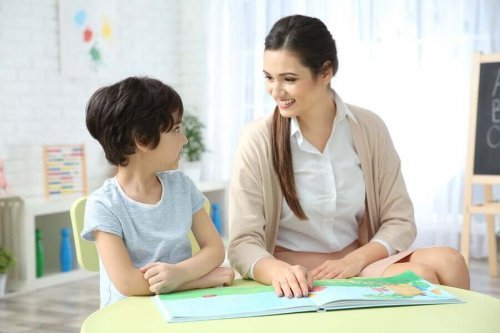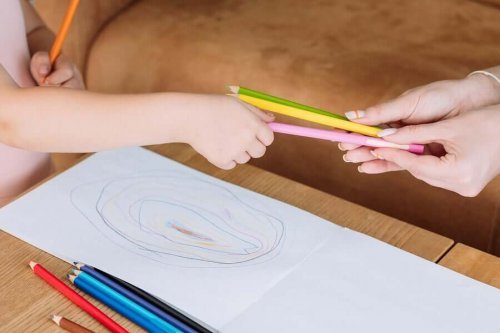The Therapeutic Use of Stories for Children

Generally, when we refer to the therapeutic use of stories, we think about their effectiveness in times of conflict. However, it goes way beyond that. Stories are a great tool in everyday life and the key is knowing how to take advantage of them correctly.
The stories that unfold in these tales not only entertain, but also help children identify a large number of issues, such as feelings, types of conflicts, and different solutions. When kids are involved in therapy, stories become a resource capable of facilitating processes and contributing to solutions.
According to experts, you can think of stories as mirrors that allow you to identify and better understand different feelings and emotions. For example, when children detect a character with fear and feel the same way, it will be much easier for them to express themselves about it and to leave it behind with some help.
Thus, we shouldn’t underestimate the therapeutic use of stories.
What is the therapeutic use of stories?
Simply put, the therapeutic use of stories consists of emotional education or, as psychologists point out, emotional literacy.

Psychologist Neva Milicic indicates that stories allow children to build a narrative about themselves and others.
On the other hand, the psychologist Adriana Diez affirms that stories facilitate the process of symbolization. That is, they help children make representations of their feelings and thoughts. Stories also help them understand meanings through symbols (which can be images, objects, words, stories, or even phrases).
With that in mind, stories go beyond fantasy and magic. In fact, it’s necessary to clarify that, in therapies with children, stories don’t always have magical elements and beings.
Many times they can deal with more common issues, such as the anger of children with their parents, in a creative way, but without resorting to gender stereotypes.
Professional use of stories

To take advantage of the full potential of the therapeutic use of stories, it’s necessary for professionals to devote time to thoroughly analyze the text. This way, they’ll not only use the content of the story but also symbology and problem-solving mechanisms as therapeutic tools.
The therapist must know how to “play” with the language of the story in order to help the children overcome their problems.
Children can elaborate on their own stories, which opens up the range of possibilities even more when looking for ways to solve problems. It allows a more personal and, perhaps, more specific approach.
Mind you, this doesn’t mean that the path of the therapist will become easier than working with classic stories.
The therapeutic use of stories in different scenarios
Although it’s the same tool we’re talking about, in reality, not all cases can benefit from the same story. A specific story or approach will have to be used depending on the problem. Thus, it’s a very versatile tool.
The ways of approaching each feeling or conflict will depend on several factors, such as the child’s age. What is certain is that, after the reading, the story is discussed with the children in order to know what they think about it.
Once therapists start to debate and reflect, they’ll proceed to highlight the most important aspects in order to help children develop their opinion about it gradually.
For example, if a character feels anger throughout the story, but in the end, he manages to express himself and releases his negative feelings, the therapist will guide the child to understand why that release is so beneficial and how to achieve it in real life.
Additionally, the therapeutic use of stories may include other activities, like drawing, writing, painting, etc.

Recommendations for therapy
Teaching and cultivating joy is very valuable for our children. Published by Cubilete, the book “My Little Joys” by Jo Witek and Christine Roussey is an ode to small everyday delights, such as a hug, the sun’s rays, a friend’s smile, and many others.
Other stories can help children better understand the feeling of frustration, such as “Sofia, the cow that loved music” by Geoffroy de Pennart. If you want to instill a respect for diversity, “Lorenzo’s Dipper” by Isabelle Carrier can be a literary wonder.
Lastly, another classic story to use for therapeutic purposes is “The monster of colors” by Ana Llenas; ideal for identifying emotions through colors.
In conclusion, the therapeutic use of stories offers enormous advantages for learning and understanding, especially in children. Stories can lead to group reflection.
This type of therapy is also very valuable when it comes to performing different tests for psychological diagnosis in children as well.
Generally, when we refer to the therapeutic use of stories, we think about their effectiveness in times of conflict. However, it goes way beyond that. Stories are a great tool in everyday life and the key is knowing how to take advantage of them correctly.
The stories that unfold in these tales not only entertain, but also help children identify a large number of issues, such as feelings, types of conflicts, and different solutions. When kids are involved in therapy, stories become a resource capable of facilitating processes and contributing to solutions.
According to experts, you can think of stories as mirrors that allow you to identify and better understand different feelings and emotions. For example, when children detect a character with fear and feel the same way, it will be much easier for them to express themselves about it and to leave it behind with some help.
Thus, we shouldn’t underestimate the therapeutic use of stories.
What is the therapeutic use of stories?
Simply put, the therapeutic use of stories consists of emotional education or, as psychologists point out, emotional literacy.

Psychologist Neva Milicic indicates that stories allow children to build a narrative about themselves and others.
On the other hand, the psychologist Adriana Diez affirms that stories facilitate the process of symbolization. That is, they help children make representations of their feelings and thoughts. Stories also help them understand meanings through symbols (which can be images, objects, words, stories, or even phrases).
With that in mind, stories go beyond fantasy and magic. In fact, it’s necessary to clarify that, in therapies with children, stories don’t always have magical elements and beings.
Many times they can deal with more common issues, such as the anger of children with their parents, in a creative way, but without resorting to gender stereotypes.
Professional use of stories

To take advantage of the full potential of the therapeutic use of stories, it’s necessary for professionals to devote time to thoroughly analyze the text. This way, they’ll not only use the content of the story but also symbology and problem-solving mechanisms as therapeutic tools.
The therapist must know how to “play” with the language of the story in order to help the children overcome their problems.
Children can elaborate on their own stories, which opens up the range of possibilities even more when looking for ways to solve problems. It allows a more personal and, perhaps, more specific approach.
Mind you, this doesn’t mean that the path of the therapist will become easier than working with classic stories.
The therapeutic use of stories in different scenarios
Although it’s the same tool we’re talking about, in reality, not all cases can benefit from the same story. A specific story or approach will have to be used depending on the problem. Thus, it’s a very versatile tool.
The ways of approaching each feeling or conflict will depend on several factors, such as the child’s age. What is certain is that, after the reading, the story is discussed with the children in order to know what they think about it.
Once therapists start to debate and reflect, they’ll proceed to highlight the most important aspects in order to help children develop their opinion about it gradually.
For example, if a character feels anger throughout the story, but in the end, he manages to express himself and releases his negative feelings, the therapist will guide the child to understand why that release is so beneficial and how to achieve it in real life.
Additionally, the therapeutic use of stories may include other activities, like drawing, writing, painting, etc.

Recommendations for therapy
Teaching and cultivating joy is very valuable for our children. Published by Cubilete, the book “My Little Joys” by Jo Witek and Christine Roussey is an ode to small everyday delights, such as a hug, the sun’s rays, a friend’s smile, and many others.
Other stories can help children better understand the feeling of frustration, such as “Sofia, the cow that loved music” by Geoffroy de Pennart. If you want to instill a respect for diversity, “Lorenzo’s Dipper” by Isabelle Carrier can be a literary wonder.
Lastly, another classic story to use for therapeutic purposes is “The monster of colors” by Ana Llenas; ideal for identifying emotions through colors.
In conclusion, the therapeutic use of stories offers enormous advantages for learning and understanding, especially in children. Stories can lead to group reflection.
This type of therapy is also very valuable when it comes to performing different tests for psychological diagnosis in children as well.
All cited sources were thoroughly reviewed by our team to ensure their quality, reliability, currency, and validity. The bibliography of this article was considered reliable and of academic or scientific accuracy.
- Jose María López Montalbán. (2009). El cuento terapéutico. [En línea] Disponible en: https://archivos.csif.es/archivos/andalucia/ensenanza/revistas/csicsif/revista/pdf/Numero_21/JOSE_MARIA_LOPEZ_1.pdf
- Arlen Fabiola Sarabia García. (2012). El cuento como herramienta en niños con discapacidad. Centro de rehabilitación infantil Teletón. México. [En línea] Disponible en: http://campus.iztacala.unam.mx/carreras/psicologia/psiclin/vol15num4/Vol15No4Art3.pdf
- García, A. F. S. (2012). El cuento como herramienta psicoterapéutica en el manejo emocional de niños con discapacidad. Revista electrónica de psicología Iztacala, 15(4), 1209-1223. https://www.medigraphic.com/cgi-bin/new/resumenI.cgi?IDREVISTA=287&IDARTICULO=38343&IDPUBLICACION=4061
- Bruder, M. (2006). El cuento terapéutico como favorecedor de la resiliencia: Una primera aproximación. Psicodebate. Psicología, Cultura y Sociedad, (6), 15-28. https://dialnet.unirioja.es/descarga/articulo/5645393.pdf
This text is provided for informational purposes only and does not replace consultation with a professional. If in doubt, consult your specialist.








